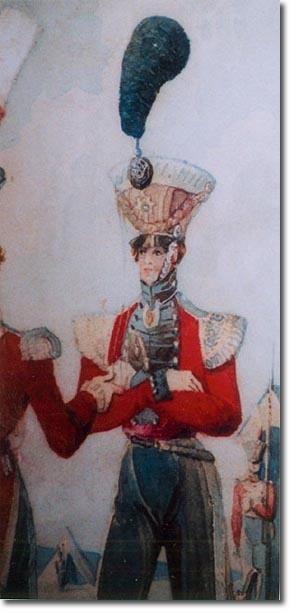|
|

 |
| Watercolour painting by D Alexander used as a basis for a print in a series published by Jas del Vecchio between 1824 and 1828. The uniforms of this period reached a point where they could not be less practical for warfare. They were designed purely for show and to make the wearer feel irresistable to women. The shako increased in height in the mid 1820s but was lowered by the early 30s. In the prints, the shako appears black as stated in regulations but for some reason it looks as if it has faded to a buff colour. The black velvet facings of the coat, however, still look dark, and the black cockade on the top of the shako is as dark as it should be to show off the silver stringed bugle badge. The green plume is huge and full, but may be exaggerated. The festoon looks gold while the lace around the top and the chin-scales are silver.
The scarlet coat has very large silver shoulder wings to denote flank company status, although field officers had epaulettes like the battalion company officers. The buttons are silver and there are no silver lace button loops on the lapels, collar and cuffs. Instead, there are twists of black silk as stipulated in the 1822 dress regulations for light infantry. The gorget is silver with a gilt device in the centre. This is contrary to the regulation laid down in 1797 that ordered all gorgets to be gilt only. He has a crimson sash around his waist, but no visible cords and tassels, and a black leather sword belt. The trousers were called cossacks and appear a lighter blue in the print, with a broad silver lace stripe. |
Armed Forces | Art and Culture | Articles | Biographies | Colonies | Discussion | Glossary | Home | Library | Links | Map Room | Sources and Media | Science and Technology | Search | Student Zone | Timelines | TV & Film | Wargames